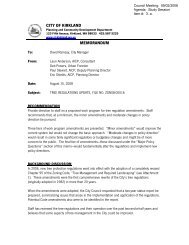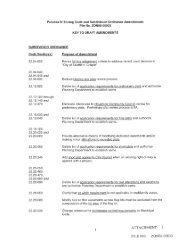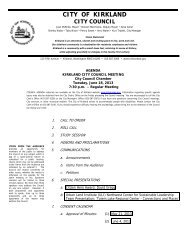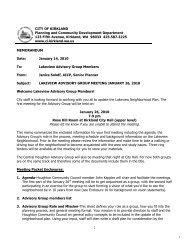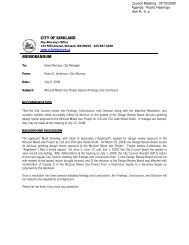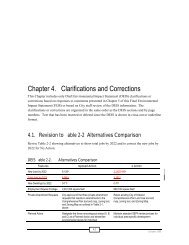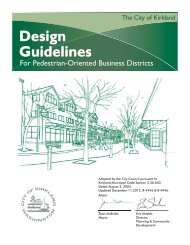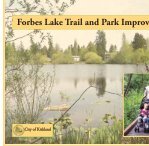Low Impact Development (LID) Feasibility Study - City of Kirkland
Low Impact Development (LID) Feasibility Study - City of Kirkland
Low Impact Development (LID) Feasibility Study - City of Kirkland
Create successful ePaper yourself
Turn your PDF publications into a flip-book with our unique Google optimized e-Paper software.
<strong>Low</strong> <strong>Impact</strong> <strong>Development</strong> (<strong>LID</strong>) GlossaryStormwater Flow Control and AttenuationBioretention swales, raingardens, and stormwater planters can reduce stormwater peak flows and volumes thatenter a conventional conveyance system via subsurface storage in soil and gravel layers, absorption <strong>of</strong> stormwaterby surrounding soils and/or the infiltration into subsoil (the layer below the topsoil). The possible reduction <strong>of</strong>stormwater volume is dependent on the available detention storage in the gravel layer and ponding area, themaximum flow rate into the subsoil, and the flow rate into the facility (related to storm intensity and drainage area)(<strong>LID</strong> Center, Inc., 2005). The cross-section <strong>of</strong> a bioretention swale can be sized to provide conveyance for any givenstorm, as required, though the more flat area there is at the bottom <strong>of</strong> a swale, the more pollutants are removed.Water Quality TreatmentStudies suggest that <strong>LID</strong> strategies that include bioretention systems, which use plants to remove pollutants, canprovide significant pollutant reductions for phosphorous, nitrogen, heavy metals, and hydrocarbons (i.e. oil andgrease) as well as reduce stormwater volumes as outlined (PSAT, WSU, 2005, pps.85-88). Bioretention systems areeffective in pollutant removal and flow reduction through processes <strong>of</strong>:• Sedimentation—slowing water to allow settling <strong>of</strong> non-soluble particulates• Filtration—straining <strong>of</strong> non-soluble particulates• Adsorption—the binding <strong>of</strong> nutrients, metal, and organics to filter media particles• Infiltration—downward movement <strong>of</strong> surface water to interstitial soil water which initiates adsorption• Phytoremediation—extraction and absorption <strong>of</strong> metals, petroleum hydrocarbons, pesticides, chlorinated solvents,and surfactants (studies illustrate that vegetated soils are more effective at pollutant removal than non-vegetatedsoils).• Plant resistance—plant materials reduce flow velocities• Thermal attenuation—reduces water temperatures as storm flows move through subsurface soil layers, which isimportant for salmonid habitat(PSAT, WSU, 2005, excerpts from pps. 85-86)Table 2 provides a comparison <strong>of</strong> pollutant removal efficiency in conventional stormwater management systemsversus <strong>LID</strong> approaches.Table 2 Comparative pollutant removal capability <strong>of</strong> stormwater treatment practices (in percentages).StormwaterManagementSystemPollutantDry ExtendedDetention Pond(Conventional)Wetlands(<strong>LID</strong>)Water QualitySwales(<strong>LID</strong>)TN (mg/L) 31 30 84 -9NO3 (mg/L) No data available ND ND ND(ND)P (mg/L) 20 49 34 -16Cu (µg/L) 26 40 51 14Pb (µg/L) 54 68 67 17Zn (µg/L) 26 44 71 0Ditches(Conventional)Source: Adapted from CWP, 2000b (removal percentages are for total metals) in (PSAT, WSU, 2005, p.87)Note: The negative numbers for Total Nitrogen (TN) and Phosphorous (P) in the Ditches column <strong>of</strong> Table 2 are possibly due to biologicalprocesses occurring in the ditch. These processes may actually be contributing to a net increase <strong>of</strong> TN and P rather than the decrease seenin the other <strong>LID</strong> elements described in the table.Bioretention swales, raingardens, and stormwater planters that capture a stormwater volume equal to 0.5” <strong>of</strong> run<strong>of</strong>ffrom an impervious area (or the water quality volume) have a 50 percent phosphorous removal efficiency. Thisphosphorous removal efficiency increases to 65 percent for bioretention and bi<strong>of</strong>iltration facilities that capture astormwater volume equal to 1.0” <strong>of</strong> run<strong>of</strong>f from an impervious area, providing significant reductions in phosporousloading (<strong>LID</strong> Center, Inc., 2005).Bioretention swales, raingardens, stormwater planters, and tree box filters can be used in commercial, residential, andindustrial areas, but should not be located in areas <strong>of</strong> high sediment loads or where the site is not entirely stabilized(<strong>LID</strong> Center, Inc., 2005). They can be used in conjunction with other <strong>LID</strong> elements that filter or capture sediment.Maintenance Needs & CostsTo ensure hydraulic efficiency <strong>of</strong> the bioretention and bioinfiltration facilities, the health and effectiveness <strong>of</strong> soil andplants, periodic inspection and maintenance to remove trash, debris, and collected sediment is required. In the event<strong>of</strong> an extreme drought, trees and shrubs may need to be watered in a similar manner as other landscaping.c<strong>City</strong> <strong>of</strong> <strong>Kirkland</strong> <strong>LID</strong> <strong>Feasibility</strong> <strong>Study</strong> for CIP Projects | SvR No. 07016 | December 21, 2007




